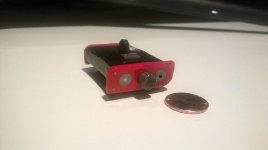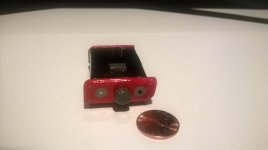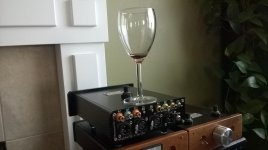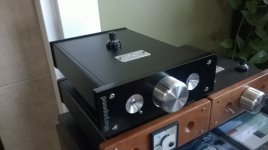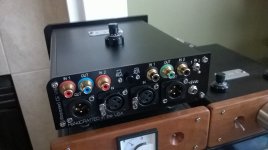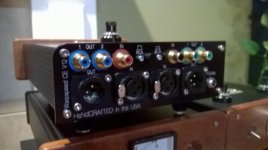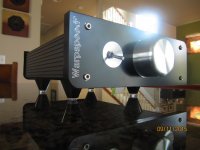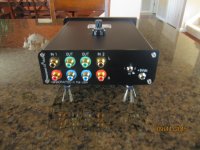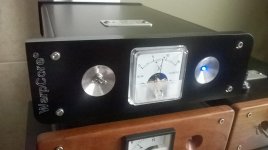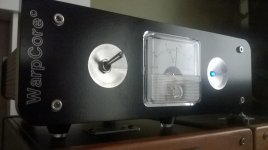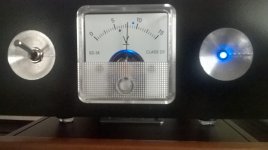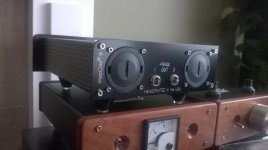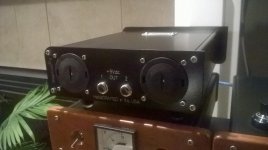AWD
Early this year I took the WarpSquid circuit meant for the Balanced V8 designs and adapted it to control Unbalanced V4s. The result takes to another level of flexibility in fine tuning each LDR in the quad of L/R series and L/R shunt. Looking back after 4+ years since the building block for the control circuit was conceptualized and then proofed, it has served well. The building block made of dual-VCCS working in tandem remains and is still the DNA of the ‘Squid. The design choices I made with regard to working voltage and current ranges proved to be optimal up to this day. Improvements along the way were the transWarp circuit and Current Source Limiting. This latest is what I now call the QuaDrive circuit which in essence is a quad-VCCS that can be individually adjusted as well as be referenced to each other to provide total control and grip. Think All-Wheel-Drive for a car or the Mars Rover’s!
It has always been my contention that optocouplers do not drift over time (ie. LDR resistance over the years do not change with the same LED bias values), provided the LEDs are fed with the optimal voltage and current. Optimized, self-heating is not an issue as well. What I observed instead is settling time. The LDR resistance value after power is applied to the LED will settle down in as short a time as 5 minutes. The same goes when a change in applied power happens like when the volume control knob is adjusted. The more rock solid the voltage and current values the better. Settling time varies in optocouplers and like all things, there will always be the odd men, the rogues and the mavericks. That is why matching is still mandatory. If settling time is not considered all the referencing, calibrating and matching will be pretty much useless. For the record, since the transWarp circuit came about my matching has been limited to a single match point! Also the latest batch of 52 yielded 12 quads!
I’ve been asked about the more recent designs with microprocessing and software involved. All I can say is “Complexity is breeding more complexity.” Apart from more parts that could fail, all sorts of high frequency hash (both modulated and intermodulated) now reside in the same chassis. Interconnects export it to the next box. External noise will be imported riding on these high frequency carriers…eventually it snowballs. In spite of all these complexities albeit convenience, still a limited steps volume control to me has the feel of a connect-the-dots picture. Like Picasso’s Cubism versus Da Vinci’s Realism, there are of course different means to our art. Pablo painted anything and called it art. Leonardo had to make it look believable to be art.
I also chose the, “Less parts, less parts that can go wrong” concept. And like a fine tuned race car it is still going to be the manual transmission kind.
Early this year I took the WarpSquid circuit meant for the Balanced V8 designs and adapted it to control Unbalanced V4s. The result takes to another level of flexibility in fine tuning each LDR in the quad of L/R series and L/R shunt. Looking back after 4+ years since the building block for the control circuit was conceptualized and then proofed, it has served well. The building block made of dual-VCCS working in tandem remains and is still the DNA of the ‘Squid. The design choices I made with regard to working voltage and current ranges proved to be optimal up to this day. Improvements along the way were the transWarp circuit and Current Source Limiting. This latest is what I now call the QuaDrive circuit which in essence is a quad-VCCS that can be individually adjusted as well as be referenced to each other to provide total control and grip. Think All-Wheel-Drive for a car or the Mars Rover’s!
It has always been my contention that optocouplers do not drift over time (ie. LDR resistance over the years do not change with the same LED bias values), provided the LEDs are fed with the optimal voltage and current. Optimized, self-heating is not an issue as well. What I observed instead is settling time. The LDR resistance value after power is applied to the LED will settle down in as short a time as 5 minutes. The same goes when a change in applied power happens like when the volume control knob is adjusted. The more rock solid the voltage and current values the better. Settling time varies in optocouplers and like all things, there will always be the odd men, the rogues and the mavericks. That is why matching is still mandatory. If settling time is not considered all the referencing, calibrating and matching will be pretty much useless. For the record, since the transWarp circuit came about my matching has been limited to a single match point! Also the latest batch of 52 yielded 12 quads!
I’ve been asked about the more recent designs with microprocessing and software involved. All I can say is “Complexity is breeding more complexity.” Apart from more parts that could fail, all sorts of high frequency hash (both modulated and intermodulated) now reside in the same chassis. Interconnects export it to the next box. External noise will be imported riding on these high frequency carriers…eventually it snowballs. In spite of all these complexities albeit convenience, still a limited steps volume control to me has the feel of a connect-the-dots picture. Like Picasso’s Cubism versus Da Vinci’s Realism, there are of course different means to our art. Pablo painted anything and called it art. Leonardo had to make it look believable to be art.
I also chose the, “Less parts, less parts that can go wrong” concept. And like a fine tuned race car it is still going to be the manual transmission kind.
Attachments
Being a headphone amp, it does have its own internal volume control? You will have to set it to max or bypass it altogether. The Warpspeed will then be inserted between your source and amp. As built the Warpspeed is a standalone volume control with the option of multiple input switching (no switch in the signal path). http://www.diyaudio.com/forums/vend...ptocoupler-volume-control-33.html#post3719733
Please pm for more details...
Please pm for more details...
New Models
After the stroll down memory lane(full text on pdf)…I would like to introduce a couple of new designs that I think will fit the needs of some audiophiles. This I believe are again firsts in optocoupler design.
The V8 R2X is a stereo XLR-in to XLR-out like a typical V8 but has an extra stereo RCA-in that can be switched to accommodate an Unbalanced source. In other words it can function as RCA-in to XLR-out. There is no gain component path that it goes through so the requisite 6dB difference compared to an XLR-in is there.
The other is the V4 X2R. It is a stereo RCA-in to RCA-out like a typical V4 but has an extra stereo XLR-in that can be switched to accommodate a Balanced source. XLR-in to RCA-out and again with the 6dB difference.
These two latest designs can afford an audiophile a chance to listen to what he may think (or a reviewer thinks) is a great Unbalanced source in his otherwise Balanced system without the prejudice of an extra gain/buffer stage. The same with a Balanced source to an otherwise Unbalanced system…most Balanced sources also have Unbalanced outs but what the heck! It is available if you need it.
Like all Warpspeed designs, all signal paths go through the LDRs only and its component leads. It may be the shortest signal path in all of audiodom. No switches, no relays, no extra LDRs, or even lengths of jumper wires –just solid solder connections between LDRs and in/out jacks. There is no electrical common connection between DC power/control circuitry with signal circuitry…totally independent. No extraneous circuitry with high frequency signals associated with microprocessors and IR signals. Plain old-school flipping of switches and twirling of the knobs are all we need. I guess I’m stuck to Leonardo da Vinci’s “Simplicity is the ultimate sophistication” mantra.
Lastly, I’ll make this short and sweet…LEDs are diode junction devices like all semiconductors and such are more voltage dependent than current. Give it just the right forward bias voltage and it will start to conduct current.
The Warpspeed did it the right way and still does.

After the stroll down memory lane(full text on pdf)…I would like to introduce a couple of new designs that I think will fit the needs of some audiophiles. This I believe are again firsts in optocoupler design.
The V8 R2X is a stereo XLR-in to XLR-out like a typical V8 but has an extra stereo RCA-in that can be switched to accommodate an Unbalanced source. In other words it can function as RCA-in to XLR-out. There is no gain component path that it goes through so the requisite 6dB difference compared to an XLR-in is there.
The other is the V4 X2R. It is a stereo RCA-in to RCA-out like a typical V4 but has an extra stereo XLR-in that can be switched to accommodate a Balanced source. XLR-in to RCA-out and again with the 6dB difference.
These two latest designs can afford an audiophile a chance to listen to what he may think (or a reviewer thinks) is a great Unbalanced source in his otherwise Balanced system without the prejudice of an extra gain/buffer stage. The same with a Balanced source to an otherwise Unbalanced system…most Balanced sources also have Unbalanced outs but what the heck! It is available if you need it.
Like all Warpspeed designs, all signal paths go through the LDRs only and its component leads. It may be the shortest signal path in all of audiodom. No switches, no relays, no extra LDRs, or even lengths of jumper wires –just solid solder connections between LDRs and in/out jacks. There is no electrical common connection between DC power/control circuitry with signal circuitry…totally independent. No extraneous circuitry with high frequency signals associated with microprocessors and IR signals. Plain old-school flipping of switches and twirling of the knobs are all we need. I guess I’m stuck to Leonardo da Vinci’s “Simplicity is the ultimate sophistication” mantra.
Lastly, I’ll make this short and sweet…LEDs are diode junction devices like all semiconductors and such are more voltage dependent than current. Give it just the right forward bias voltage and it will start to conduct current.
The Warpspeed did it the right way and still does.

Attachments
Warpspeed model lineup:
V4 1-in, 2-out (parallel) RCA; stereo volume control with balance control
V4x2 2-in, 2-out (parallel) RCA; stereo volume control with balance control
V4x3 3-in, 2-out (parallel) RCA; stereo volume control with balance control
V4 X2R 1-in RCA, 1-in XLR, 2-out (parallel) RCA; stereo volume control with balance control (New)
V8 1-in, 1-out XLR; stereo volume control with balance control
V8.1 1-in, 2-out (parallel) XLR; stereo volume control with balance control
V8.2 2-in, 1-out XLR; stereo volume control with balance control
V8 R2X 1-in RCA, 1-in XLR, 1-out XLR; stereo volume control with balance control (New)
V12 1-in, 2-out (parallel) RCA; 1-in, 1-out XLR; stereo volume control with balance control
V16 2-in, 1-out RCA; 1-in, 1-out XLR; stereo volume control with balance control
V24 6-in, 6-out RCA; 6-channel level control with main volume control (No longer made)
WarpCore 9 2-out; 9 volts D-cell battery supply

V4 1-in, 2-out (parallel) RCA; stereo volume control with balance control
V4x2 2-in, 2-out (parallel) RCA; stereo volume control with balance control
V4x3 3-in, 2-out (parallel) RCA; stereo volume control with balance control
V4 X2R 1-in RCA, 1-in XLR, 2-out (parallel) RCA; stereo volume control with balance control (New)
V8 1-in, 1-out XLR; stereo volume control with balance control
V8.1 1-in, 2-out (parallel) XLR; stereo volume control with balance control
V8.2 2-in, 1-out XLR; stereo volume control with balance control
V8 R2X 1-in RCA, 1-in XLR, 1-out XLR; stereo volume control with balance control (New)
V12 1-in, 2-out (parallel) RCA; 1-in, 1-out XLR; stereo volume control with balance control
V16 2-in, 1-out RCA; 1-in, 1-out XLR; stereo volume control with balance control
V24 6-in, 6-out RCA; 6-channel level control with main volume control (No longer made)
WarpCore 9 2-out; 9 volts D-cell battery supply

- Home
- Vendor's Bazaar
- Warpspeed -An Optocoupler Volume Control

